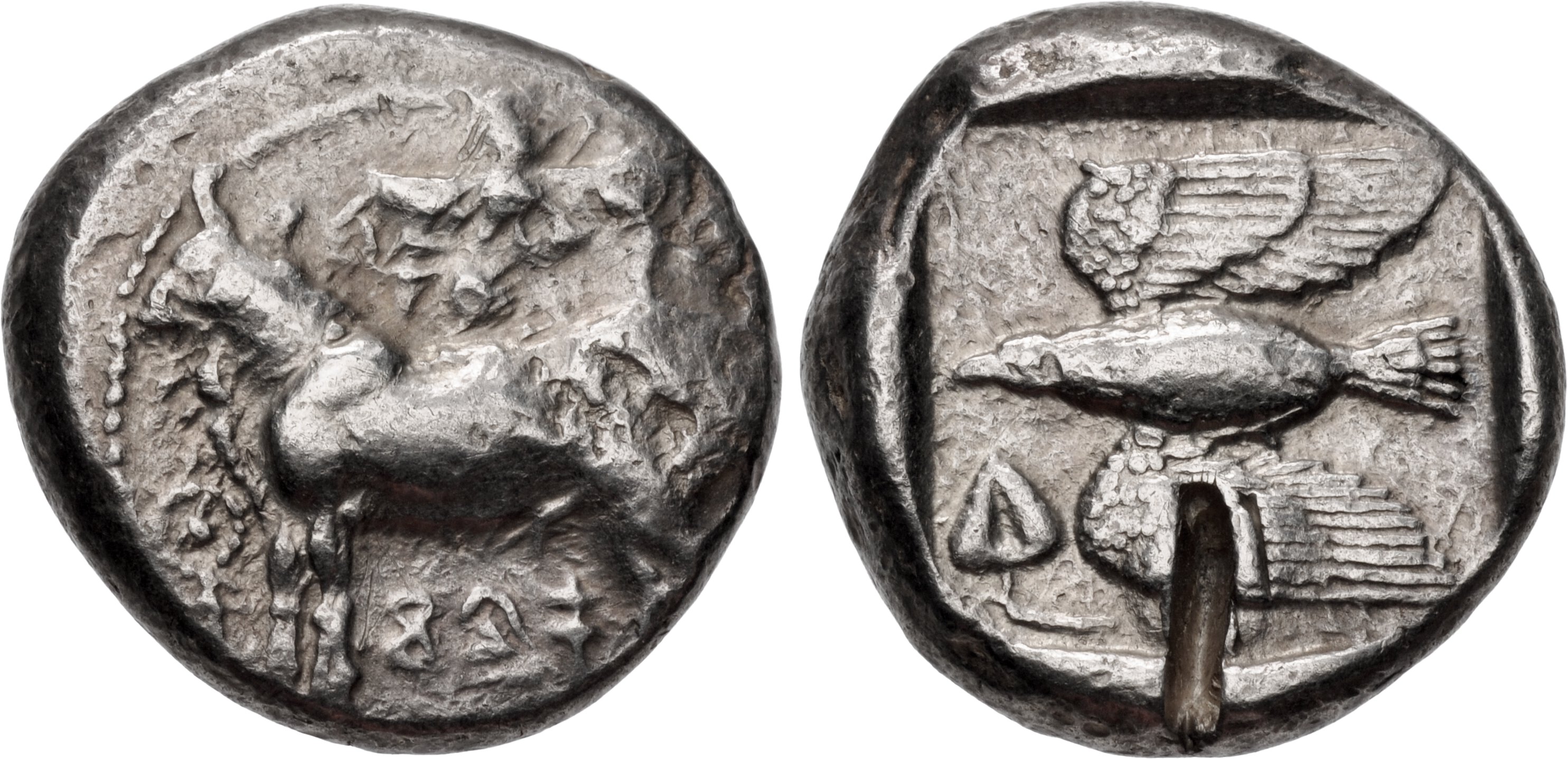465 BCE - 430 BCE | EΣ-T-F counterclockwise around from lower left
Overstriking coin
Aspendus_21314_CNG.jpg
[1]
|
|
Sale(s)Sale(s) ᵖ:
|
Classical Numismatic Group, EA 451, 4 Sept. 2019, 149
|
|
|
|
Description
| ObverseInscription or printing placed on the obverse.:
|
Warrior advancing right, holding shield and spear
|
ReverseInscription or printing placed on the reverse.:
|
EΣ-T-F counterclockwise around from lower left (Greek) Triskeles, all within incuse square
|
Mint and issuing power
| MintIdentifies the place of manufacture or issue of a numismatic object.:
|
Aspendus
|
Ancient regionAncient region.
|
Pamphylia
|
Modern countryModern country: Turkey
|
AuthorityIdentifies the issuing power. The authority can be "pretended" when the name or the portrait of X is on the coin but he/she was not the issuing power. It can also be "uncertain" when there is no mention of X on the coin but he/she was the issuing power according to the historical sources:
|
Persian Empire
|
Chronology
| FromIdentifies the initial date in a range assigned in a numismatic context. 465 BCE toIdentifies the final date in a range assigned in a numismatic context.. 430 BCE
|
Classical 480-323 BC  periodTime period of the numismatic object. periodTime period of the numismatic object.
|
Physical description
MetalThe physical material (usually metal) from which an object is made.: Silver 
|
WeightWeight of the numismatic object (in grams). in grams: 11.1111.11 g <br />11,110 mg <br />
|
DenominationTerm indicating the value of a numismatic object. Examples: tetradrachm, chalkous, denarius.: double siglos 
|
AxisDescribes the directional relationship between the obverse and reverse of a numismatic object.: 1212 mm <br />1.2 cm <br />
|
| DiameterDescribes diameter of an object (in mm).: 2222 mm <br />2.2 cm <br />
|
StandardStandard.: Persian
|
References
Description
| ObverseInscription or printing placed on the obverse.:
|
[ ]-pa-si-[ ] (in Cypriot) above, pa-si-le (in Cypriot) below (Cypriot) Bull standing left, winged solar disk, ankh to left
|
ReverseInscription or printing placed on the reverse.:
|
Eagle flying left, ivy leaf to lower left, all within incuse square
|
Mint and issuing power
| MintIdentifies the place of manufacture or issue of a numismatic object. ᵖ:
|
Paphos
|
Ancient regionAncient region. ᵖ
|
Cyprus
|
Modern countryModern country: Greece
|
AuthorityIdentifies the authority in whose name (explicitly or implicitly) a numismatic object was issued. ᵖ:
|
|
Chronology
| FromIdentifies the initial date in a range assigned in a numismatic context. 455 BCE toIdentifies the final date in a range assigned in a numismatic context.. 440 BCE
|
Classical 480-323 BC  periodTime period of the numismatic object. periodTime period of the numismatic object.
|
Physical description
| DenominationTerm indicating the value of a numismatic object. Examples: tetradrachm, chalkous, denarius. ᵖ:
|
stater 
|
|
|
References
References
- ^ Babelon, Ernest (1901-1932), Traité des monnaies grecques et romaines, Paris, E. Leroux
- ^ Sylloge Nummorum Graecorum. Sammlung v. Aulock. Pamphylien. 11 Heft (n° 4477-4893), Berlin, 1965.
- ^ Levante, Edoardo [with the collaboration of Peter Weiss] (2001), Sylloge nummorum graecorum. France. 3, Département des monnaies, médailles et antiques : Pamphylie, Pisidie, Lyaconie, Galatie, Paris-Zürich, Bibliothèque nationale de France-Numismatica Ars Classica, XXXIV + 293 p. and 146 pl.
- ^ Zapiti, Eleni - Michaelidou, Lefki (2008), Coins of Cyprus : from the collection of the Bank of Cyprus Cultural Foundation, Nicosia, Bank of Cyprus Cultural Foundation, 329 p.

